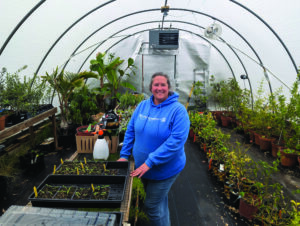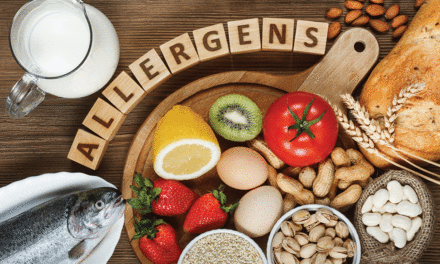
Christy Little of A Little Farm and Nursery in Stevensville, said she enjoys the control and creativity starting seeds offers in going beyond the traditional and most popular varieties. (Photo by Sean Clougherty)
A growing season can test a gardener in many ways, but if you’re starting seeds indoors when the weather is still cold, the answers are pretty easy to get.
According to local Master Gardeners, the first rule of seed starting is: Follow the recommendations on the back of the seed packet.
“It’ll tell you all the fun stuff that you need to know how to grow,” said Christy Little, owner of A Little Farm and Nursery in Stevensville.
While the front of the packet has a gorgeous picture of the flower or fruit you’re about to grow, the back has the nuts and bolts you need to do it right. Seeding depth, growing time before planting, soil and air temperature are a few of the key points.
“The back of the seed packet is so instructive,” said Queen Anne’s County Master Gardener Susan Edwards of Centreville, who grows vegetables and cut flowers and has been starting her own seeds for a decade. “They give it right to you and sometimes we don’t do it.”
Edwards said starting her own seeds takes a lot of planning and organization, but also allows her to be creative in choosing varieties that are outside the ordinary fare of a garden center’s lineup.
“I like to plan and you’re allowed to constantly try new things,” Edwards said. “You also know what’s going in your body.”
Timing is a big part of the plan. Little recommends looking ahead to the time you want to transplant out doors and work back from that for a starting date, using the seed packet information.
“A lot of people will decide based on frost date,” Little said.
The next necessary things are sources of heat and light. Heat mats under trays of planted seeds and lights over top are common for perennial self-starters like Edwards. Cost of both, especially lighting with the advancement of LEDs, has come down to a more reasonable level, she added. She and Little also utilize a heated greenhouse for some plants, but said the low-tech option of a sunny windowsill can work, too. Just remember to rotate the tray or pots for even exposure.
Meeting light requirements keeps plants from getting “leggy” or growing too tall and stretching out in search of more light. Tomatoes for example, need 12 hours of light a day. LED lighting also has a wider range of height it over the seedlings as opposed to fluorescent lighting, giving more flexibility, Edwards said.
Little and Edwards advocate reusing trays and pots but only after a good washing with soap and water or mild bleach solution to nullify any residual disease that may have lingered from last year.
Tammy Sons, owner of TN Nursery in Tennessee, recommends a light seed-starting mix that drains well and creates a good medium for roots development. Seed trays or pots also need adequate drainage.
The environment should remain stable between 65-75°F while soil moisture levels stay even without reaching waterlogged conditions, Sons added.
Fertility and water — the right amounts of both — are important to keep plants healthy and hardy once they’ve sprouted. As the plants grow, consider “potting up” into a larger container to foster more growth and root production before planting outside.
“They’ll tend to use up all the fertilizer in that soil so transplanting and fertility are important as you pot up,” Little said.
Plants like a little test of their own, too. To get them ready for outdoor living, they need to be taken outside for a few hours in the days leading up to transplanting. Edwards and Little also run a fan over plants or routinely brush over them gently with their hand to get them ready.
“It toughens up the stalks and the roots are more robust when they have that movement,” Little said.
Little also recommends planting a few more seeds than you plan to actually plan to plant. Not all will turn out the best and it will give you a better chance at a good crop. The flip side of that coin, however, is resisting the urge to plant every green stem that grows.
“It’s OK to let some go,” Little said.




